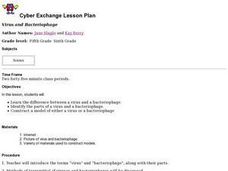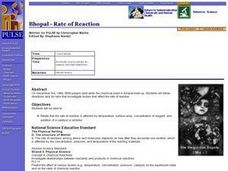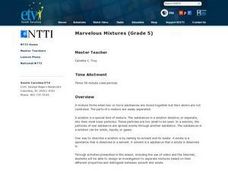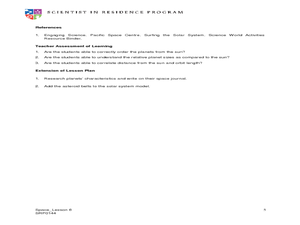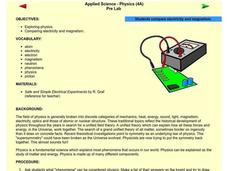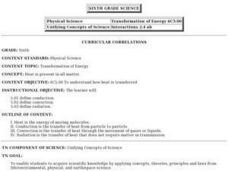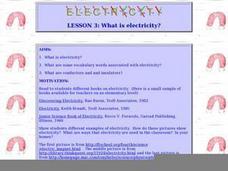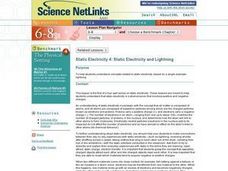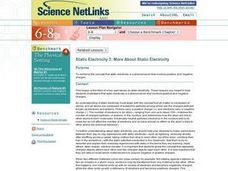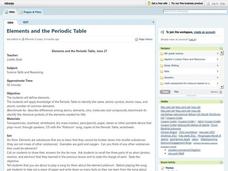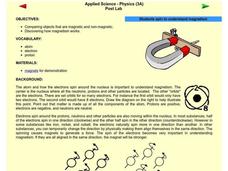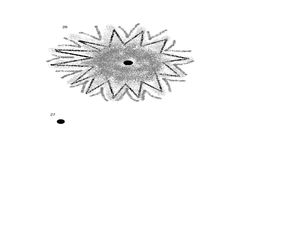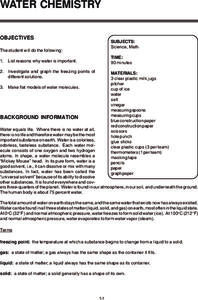Curated OER
Teaching Radioactive Decay: Radioactive Half-life And Dating Techniques
Students generate a radioactive decay table for an imaginary element using a box filled with pinto beans and M&M's. They use their data to plot a decay graph, develop the concept of half-life, and use the graph to "age" several samples.
Curated OER
Virus and Bacteriophage
Students examine the differences between a virus and a bacteriophage. They explore various websites, identify the parts of a virus and a bacteriophage, and construct a model of a virus or bacteriophage.
Curated OER
Bhopal - Rate of Reaction
Students determine that the rate of reaction is affected by temperature, surface area, concentration of reagent, and addition of a catalyst or inhibitor. They observe that on December 3rd, 1984, 8000 people died when the chemical plant...
Curated OER
Will the Lights Go Out?
Students diagram nuclear power plant, describe process for generating electrical power, discuss nuclear disasters in the 20th century, and draw conclusion about value of nuclear power for the future.
Curated OER
Polymer Basics
In this polymer worksheet, students use an on line site to complete sentences about plastics, their chemical make-up, their uses, their history and information about recycling plastics.
Curated OER
Heat Transfer & Phase Changes
In this heat transfer and phase change worksheet, students experiment with ice, salt, and milk to show the relationship between the temperature of a solution and its phase. Students turn milk from a liquid to a solid and graph the...
Curated OER
Stiochiometry: Quantifying Changes in the Environment
Students examine stoichiometry. In this chemical reaction and mole lesson, students complete an experiment based on readiness levels to explore that changes are quantified in chemical reactions.
Curated OER
Marvelous Mixtures
Fifth graders design an experiment in which they separate mixtures. In this mixtures lesson, 5th graders define mixtures, solutions, solutes, and solvents. They watch a video, complete worksheets, and perform an experiment to separate...
Curated OER
Static electricity: Ah, There's the rub!
Students experiment to investigate static electricity. For this static electricity lesson, students prepare a balloon head and draw a face on it. Students rub the nose and the balloon moves toward the student rubbing.
Curated OER
Space: Our Star, the Sun, and Its Friends, the Planets
Students examine the solar system. For this space lesson, students identify the order of the planets and their relative size to the sun. Students create a scale model of our solar system using a variety of household objects.
Curated OER
Electricity and Magnetism
Fourth graders compare electricity and magnetism. In this science lesson plan, 4th graders discuss the concepts of electricity and magnetism and brainstorm examples of electrical and magnetic forces.
Curated OER
Where's the Period in the Periodic Tables?
Students investigate the Periodic Table of Elements. The teacher is provided with the necessary background information to complete the lesson. Students practice matching the element symbol to its place on the chart.
Curated OER
Transformation of Energy: Heat
Sixth graders investigate how heat is transferred and the concepts of conduction, convection, and radiation. They define key vocabulary terms, and observe teacher-led demonstrations of conduction, convection, and radiation.
Curated OER
Water and Ice
Students observe water as it changes form. For this water lesson students observe, measure, and describe water as it changes state.
Curated OER
What Is Electricity?
Students investigate vocabulary words associated with electricity. In this electrical lesson, students utilize the Internet to research what electricity is and how it works. Students create an actual circuit in class using a...
Curated OER
Static Electricity 4: Static Electricity and Lightning
Students explain concepts related to static electricity, based on a single example: lightning.
Curated OER
Static Electricity 3: More About Static Electricity
Students reinforce the concept that static electricity is a phenomenon that involves positive and negative charges.
Curated OER
Understanding Oxidation Numbers
Students review atomic numbers, positive and negative charges, and the periodic table. They examine the relationships among protons and electrons, location of various elements, electron energy levels, and oxidation numbers.
Curated OER
Recognizing and Describing Chemical Changes
Seventh graders distinguish between physical and chemical changes in both natural and technological settings. They identify the reactants and products for a given chemical reaction. they then write simple chemical equations given the...
Curated OER
Elements and the Periodic Table
Students are introduced to the elements on the Periodic Table and what is meant by element. Using the Table, they identify the name, atomic mass, number and symbol of each element. To end the instructional activity, they discover the...
Curated OER
Magnetism
Students study magnetism. In this science lesson, students participate in an activity to discover how electrons in a magnet move. Students identify items around the classroom that are magnetic.
Curated OER
A Peek into the Lives of Stars!
Students create a model of the birth of a star and demonstrate the stages of the star's lifecycle. For this star lifecycle lesson, students mix flour and water in a jar to model the birth of a star, then role-play the entire...
Curated OER
Help Wanted: A Lighting Engineer For Popular Rock Group
Students are assigned to groups, and determine each member's role in the group. They will design an experiment to determine a way to produce the three primary and five secondary colors. Students discuss color and mood. They listen to a...
Curated OER
WATER CHEMISTRY
Students list reasons why water is important and investigate and graph the freezing points of different solutions.
Other popular searches
- Atoms and Matter
- Atoms Basic Unit of Matter
- Atoms Basic Unit of Matter
- Matter Atoms Molecules
- Atoms Matter Experiments

